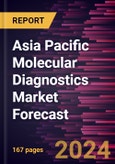Advancements in Molecular Diagnostics Technologies Fuels Asia Pacific Molecular Diagnostics Market
Molecular diagnostic techniques and platforms are being used in all areas of anatomic and clinical pathologies. DNA or RNA sequences that are associated with disease, including single nucleotide polymorphism, deletions, rearrangements, and insertions, can be detected in molecular diagnostic tests. Molecular diagnosis has undergone further improvements after the emergence of COVID-19. Conventionally, CT scans, hematological tests, and RT-PCR were in use for testing. As COVID-19 cases grew rapidly in 2020, the need for rapid, precise testing platforms surged to overcome the disadvantages of conventional testing. Computed tomography (CT), a cost-intensive procedure that may not be available in all hospitals, fails to detect viral infections and other diseases in asymptomatic patients. RT-PCR, which was widely used, was also time-consuming and expensive, and was unable to detect a low viral load during the early stages of infection. Consequently, researchers developed novel approaches to detect SARS-CoV-2, which were faster and more cost effective. Reverse transcription loop-mediated isothermal amplification (RT-LAMP), microarray-based detection, aptamer-based diagnosis, SHERLOCK, SHERLOCKv2, FET Biosensors, cell-based potentiometric diagnosis, and molecular imprinting technology are a few of the examples of novel molecular diagnostics techniques developed for COVID-19 diagnosis. In the last few years, FDA reports have indicated that advancements in molecular testing, antigen-dependent testing, and serological testing have been approved. Collaborative efforts by scientific communities in different countries to manage the COVID-19 pandemic and reduce the extent of mortality have benefited the overall molecular tools and diagnosis landscape, which is likely to create significant opportunities for the molecular diagnostics market in the future.Asia Pacific Molecular Diagnostics Market Overview
Asia Pacific includes Malaysia, Thailand, India, Singapore, the Philippines, Vietnam, Indonesia, China, Japan, Australia, South Korea, and the Rest of Asia Pacific. Rising geriatric population, increasing cancer cases, growing technological advancements, and increasing number of startups, biotechnology, and biopharmaceutical companies are driving the molecular diagnostics market in this region. Moreover, the rise in research activities in the region and the presence of associations or organizations enhancing the quality of care in cancer contribute to the molecular diagnostics market growth.Asia Pacific Molecular Diagnostics Market Revenue and Forecast to 2030 (US$ Million)
Asia Pacific Molecular Diagnostics Market Segmentation
The Asia Pacific molecular diagnostics market is segmented into disease area, technology, product and services, end user, and country.Based on disease area, the Asia Pacific molecular diagnostics market is segmented into infectious disease, oncology, genetic testing, cardiac diseases, immune system disorders, and others. The infectious disease segment registered the largest Asia Pacific molecular diagnostics market share in 2022.
Based on technology, the Asia Pacific molecular diagnostics market is segmented into polymerase chain reaction (PCR), in situ hybridization, isothermal nucleic acid amplification technology (INAAT), DNA sequencing and next-generation sequencing (NGS), DNA microarrays, and others. The polymerase chain reaction (PCR) segment registered the largest Asia Pacific molecular diagnostics market share in 2022. The polymerase chain reaction (PCR) is further sub segmented into RT-PCR, qPCR, multiplex PCR, and others.
Based on product and services, the Asia Pacific molecular diagnostics market is segmented into assays and kits, instruments, and services and software. The assays and kits segment registered the largest Asia Pacific molecular diagnostics market share in 2022.
Based on end users, the Asia Pacific molecular diagnostics market is segmented into diagnostic laboratories, hospitals and clinics, research and academic institutes, and others. The diagnostic laboratories segment held the largest Asia Pacific molecular diagnostics market share in 2022.
Based on country, the Asia Pacific molecular diagnostics market has been categorized into India, Singapore, Malaysia, Philippines, Thailand, Indonesia, Vietnam, China, Japan, Australia, South Korea, and the Rest of Asia Pacific. China dominated the Asia Pacific molecular diagnostics market in 2022.
Abbott Laboratories, Agilent Technologies Inc, Thermo Fisher Scientific Inc, F. Hoffmann-La Roche Ltd, Qiagen NV, bioMerieux SA, Illumina Inc, Danaher, Siemens Healthineers AG, Novartis AG, and TBG Diagnostics Limited are some of the leading companies operating in the Asia Pacific molecular diagnostics market.
Reasons to Buy
- Save and reduce time carrying out entry-level research by identifying the growth, size, leading players and segments in the Asia Pacific Molecular Diagnostic market.
- Highlights key business priorities in order to assist companies to realign their business strategies
- The key findings and recommendations highlight crucial progressive industry trends in the Asia Pacific Molecular Diagnostic market, thereby allowing players across the value chain to develop effective long-term strategies
- Develop/modify business expansion plans by using substantial growth offering developed and emerging markets
- Scrutinize in-depth Asia Pacific market trends and outlook coupled with the factors driving the molecular diagnostics market, as well as those hindering it
- Enhance the decision-making process by understanding the strategies that underpin commercial interest with respect to client products, segmentation, pricing and distribution
Table of Contents
Companies Mentioned
- Abbott Laboratories
- Agilent Technologies Inc
- bioMerieux SA
- Danaher
- F. Hoffmann-La Roche Ltd
- Illumina Inc
- Novartis AG
- Qiagen NV
- Siemens Healthineers AG
- TBG Diagnostics Limited
- Thermo Fisher Scientific Inc








